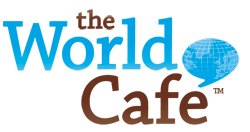 A few weeks ago my/our friend Michael Jones (yes, the brilliant pianist) shared a remarkable story of his innovative work integrating the arts and a sense of place into the unique World Cafés he hosts. I asked him to please write up his experiences so that others can learn from what he’s doing, and this is what he sent:
A few weeks ago my/our friend Michael Jones (yes, the brilliant pianist) shared a remarkable story of his innovative work integrating the arts and a sense of place into the unique World Cafés he hosts. I asked him to please write up his experiences so that others can learn from what he’s doing, and this is what he sent:
Meetings Among the Many
A Dialogue on Community Wellbeing and The Significance of Place
“When every place looks the same- there is no such thing as place any longer.”
James Howard Kunstler – Geography to Nowhere
Beginning the New Conversation
Around the world a consensus is growing about the need for a more holistic and transparent way to measure societal progress, one that accounts for more than just the economic indicators such as GNP and takes into account the full range of concerns of the community.
In the context of this global movement, in November 2008, leaders in health, culture, public administration, the aboriginal community, students and many others in the Simcoe Muskoka region north of Toronto, Canada met together at The Fern Resort for an historic occasion. Through the day they engaged in conversations as part of the pre-launch of the Canadian Index of Wellbeing, a new and transformational initiative founded by the Hon. Roy Romanow that will report on the wellbeing of all Canadians.
The introduction of music, art, time in nature, story-telling, seeded dialogue, small table conversations and personal reflection shifted the focus from strategic planning and priority setting to a more generative process that allowed time and space to come into the moment, to listen and to speak from the heart and to engage the questions that mattered most to their communities. In this respect the day offered a new and emergent model for what could be possible in future CIW – community partnerships and collaborations.
At the heart of these collaborations is the commitment to bring together diverse members of the community in cross sector and multi-generational dialogues to inquire into the significance of place, arts and culture, identity and the other domains of the CIW. Through creating a ‘conversation commons,’ communities will have the opportunity to imagine and reflect on questions that will influence the quality of their well being now and into the far future. For example;
- What are the places and spaces in our community where we experience the greatest sense of aliveness, vitality and significance?
- When we think about the relationship of our built environment, the health of our population and community well being – what really matters?
- To build the ground for our future, what do we want to conserve and what needs to change?
- What new story is possible with the Community Index for Wellbeing and what kind of leadership will be needed to bring this story into reality?
All Place is Meeting
Sherry Lawson was our opening speaker. She is a highly regarded local native writer and storyteller.
To help us truly appreciate the significance our meeting for the day, I wanted to share a few words about how the story of place has been passed along in Sherry’s community. This framing may bring to life the depth of conversations we shared together. In the narrative of her community ‘all place is meeting’ – it is held in the mythology of Mnjikaning, the home of the Chippewa First Nations on the land where the conference was held and the place that Sherry calls home.
Mnjikaning means “ keepers of the fish fence” The fence or weirs, as they are also known, is located in the Narrows, a small channel that links two large lakes; Simcoe a broad bowl like and wind swept lake to the south and Couchiching a narrow, long, winding finger lake to the north. The Narrows is just a mile or so down along the shore from the site of our meeting.
For 5000 years the tribes traveled long distances to gather at The Narrows every winter and survived on the fish that were caught in the weirs there. It is where they met the first European settlers many of whom were suffering from physical, emotional and spiritual impoverishment and distress. For years the Indians helped restore them to health. Over centuries the story of meeting was carried not only as a bridge to unite the diversity of tribes and cultures – this story also animated their environment – carried along in the gentleness of the soil, the wind, the water, the light and the sky.
Their land is also a meeting place – an ‘ecotone’ that marks the edge of the limestone plain and warm shallow lakes to the south with the deep granite cold trout lakes of the pre-Cambrian shield to the north. Sherry’s people learned to be masters of two worlds- to learn to hunt and fish and know intimately the complex ecology of each domain with its distinct fish, fauna, vegetation, and animal life.
So when Sherry introduced her story with the words “Welcome! You are now on Indian land and need to learn in Indian ways ” – it is this 5000 year story of meeting together that holds the ground of being of which she speaks.
As conference participants were invited to step outside in the natural environment for a time – to find a place of aliveness that attracted their interest and let it speak to them- much as Sherry in her introductory story of place let her ancestors speak to her through the gravestone – it was to engage this ancient story of meeting again. It is the perennial story that could be felt in the fresh warm breezes and waters of Lake Couchiching that early November afternoon. (Couchiching in Chippewa translates as the Lake of Many Winds)
For the communities that make up Simcoe Muskoka, the regional pre-launch of the Community Index for Well Being, it is also an invitation to listen again for Mnjikaning’s timeless story of the ‘meetings among the many.’ It is a reminder, and an invitation, to a way of being together that may serve as our new ground of being as well.
Postscript
If there is a parallel to the keepers of the fish fence in the non-native tradition it may be the stewardship of the commons – the plaza, the village green, the front porch are a few examples of the commons – a possibility space for chance encounters and meetings among strangers. In recent years the community of Orillia has been host to The Orillia Commons, The Community Cultural Roundtable, The design of the new market/public square and a spacious light filled learning commons located in phase one of new satellite campus for Lakehead University… And the community of Mnjikaning/Rama has developed Casino Rama the most financially successful casino in Canada and a meeting place for visitors and entertainers from around the globe.
………………………………………………………………………………………………
Many thanks to storyteller and author Sherry Lawson, our panel; Architect Paul Whelan, Dr Charles Gardner, Medical Officer of Health for Simcoe County and artist/ educator Joanna McEwen, Project Director Gary Mahan, Lynne Slotek, Project Director for the CIW and The Atkinson Charitable Foundation, The North Simcoe Muskoka CIW Working Group including; The Local Health Integration Network, United Way, The Simcoe Muskoka Public Health Unit, Barrie Community Health Center, Georgian College as well as the contributions of Saragrafix, Rowan Media, and Lauri Prest at Providence Care. And also a special thanks to Mark Douglas Biidaanakwad (Cloud Approaching) from whom I first heard the story of the keepers of the fish fence and to the World Café Community, which inspired the architecture for the day.
Michael Jones is a dialogue facilitator, leadership consultant, speaker, author and pianist/ composer. He was retained by the CIW national project director at the Atkinson Charitable Foundation and the Simcoe Muskoka CIW working group as the principle designer and creative facilitator for the pre-launch of the CIW at The Fern Resort near Orillia this past November.



0 Comments